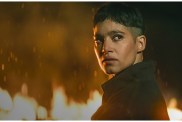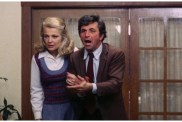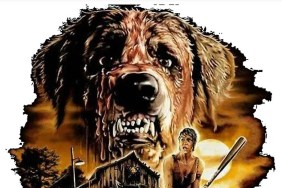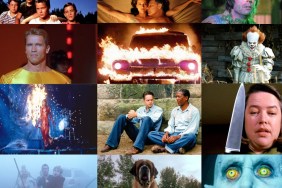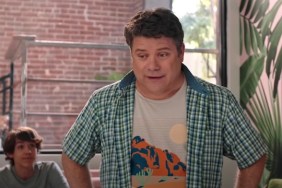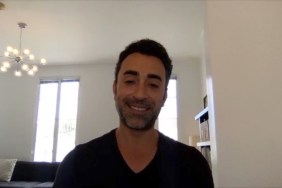New book charts the making of Lewis Teague’s 1983 Stephen King shocker Cujo
Lewis Teague’s eco-horror masterpiece Cujo, made an entire generation of horror fans think twice before allowing their beloved canines off the leash. More than thirty years on, Melbourne based film historian Lee Gambin (who occasionally writes for this very site) revisits the film adaptation of Stephen King’s novel, in the extensive tome “Nope, Nothing Wrong Here: The Making of Cujo.”
Gambin’s previous work – “Massacred by Mother Nature: Exploring the Natural Horror Film” and “We Can be Who We Are: Movie Musicals from the 1970s” – displays his endless knowledge of cinema, along with his ability to provide new insight into much loved films. “Nope, Nothing Wrong Here” continues in this vein as Gambin talks with countless people involved in the production of Cujo. Including Dee Wallace, Danny Pintauro and his parents and the film’s animal trainers, each providing unique insight into the making of Cujo.
We’ve asked Gambin to give us a taste of what we can expect from his book as he discusses ten little known facts about horror’s iconic canine.

ComingSoon.net: Peter Medak was originally the assigned director for Cujo. Are you aware of any footage he shot before he left the project?
Lee Gambin: Absolutely. Peter Medak had shot an opening sequence that took place in a cemetery. He talks about it in detail for my book. Initially the sequence would act as the opening titles and start off looking over a busy freeway at night in Mendocino which stood in for Stephen King’s fictional town of Castle Rock, Maine (the setting of CUJO, as well as other King works) and the headlights from the zooming cars would evoke an ominous tone. From the freeway Medak directed the course of action to the cemetery where we would meet the vampire bat that would eventually infect Cujo with rabies. There was a massive connection made to the supernatural in the initial screenplay by writer Barbara Turner (who was hired after Stephen King was dropped from the project as screenwriter). She had taken cue from King’s connective tissue to his previous novel “The Dead Zone” and used the Frank Dodd character (now dead, but still a haunting presence) as an influence in the evil that will permeate this opening sequence. Apparently it was an elaborate shoot involving a crane and difficult complicated angles that took a long time, which essentially infuriated producer Dan Blatt who then eventually fired Medak and his DOP Tony Richmond and the rest is history. Interestingly enough, the cemetery actually appears in the final cut of the film when Dee Wallace and Danny Pintauro drive past it in the ailing Pinto. There are a lot of crazy stories regarding this entire sequence from not only Medak and Richmond but other people who were on the film under Medak’s direction.
RELATED: Stephen King’s Firestarter coming to Blu-ray
CS: Did Peter Medak’s sudden departure have any major effects on the cast and crew?
Gambin: Most definitely the crew! From what I hear most of the camera department, sound department and additional company members really loved Tony Richmond, and those who worked with Peter Medak could only say lovely things about him. The film was a non-union production and a lot of the crew ended up coming from Utah and worked under Lewis Teague’s direction, who did a phenomenal job. However, there was some sadness from certain people who missed Peter Medak. Medak’s son Christopher stayed on the project as a production assistant and he shares some interesting stories regarding the change in directors. However, you have to understand Lewis Teague was initially hired to do the film because he was suggested by Stephen King himself who really loved his excellent film Alligator from 1980. Politics intercepted, and Peter Medak (who had wowed critics and audiences with The Changeling) was picked up by the studio but of course artistic differences with producer Dan Blatt kicked in and he was let go. Medak was devastated. During my interview with him he was completely candid about his feelings and absolutely depressed by the situation.

CS: You’ve talked extensively with the daughter of animal trainer, Karl Lewis Miller, Teresa Ann Miller. Karl’s work in Cujo is so impressive. Is Miller’s background specifically in dog training?
Gambin: Most definitely. Among other animals of course, but Miller’s work was primarily dealing with dogs of all breeds. He was an incredible man who was devoted to his animals and not only an amazing trainer and wrangler, but an activist. His daughter Teresa (who is also a leading animal trainer who did some phenomenal work in the very important movie White God (2014)) shared some beautiful stories regarding him. She discusses the fact that her father wanted the producers on Cujo to change the breed of dog for the movie, suggesting they use a Doberman instead! Miller had worked with Dobermans quite often in films such as They Only Kill Their Masters (1972) and found them incredibly easy to train, he had never worked with St. Bernards before. Of course, the character of Cujo is a St. Bernard, so Miller set out to find a group of this specific breed to all contribute. These dogs lived on his ranch with him and his family, and the exact number of St. Bernards used varies depending on who you speak to. But the core dogs were Cubby, Daddy and Moe who all excelled at different things such as long distance running, lunging, growling and so forth. I feel Karl Lewis Miller’s legacy will be well represented in this book and besides his amazing work on CUJO, you really need to go back and look at his superb animal action success with films such as The Pack (1977), White Dog (1981) and many more.
CS: The majority of the film’s tension takes place at the Camber residence. Can you tell me a little about the background of the location?
Gambin: Oh its an amazing story in itself! It was a farm house out in Santa Rosa, surrounded by large oak trees. The creepiest element here is that the house used to be owned by a family who had a son who hung himself on one of the trees. Funnily enough, the crew at one point – who were quite fond of libations here and there – grabbed hold of a stunt dummy that was made but never used – and hung it out on a branch of a large oak tree unbeknownst to them that this tragic event had happened some years earlier. Needless to say, they were scolded the next day by producers! Also, Danny Pintauro’s mother Margaret was heavily interested in clairvoyance and all things spiritual and esoteric. She was there during the whole shoot watching her son perform, and during the production she would apparently sense the presence of the young man’s spirit haunting the house.

CS: One thing I really enjoy about your writing is your ability to make unusual connections within films. What unexpected connections did you discover during your research for the book?
Gambin: Without giving too much away, I will talk about one very cool connection that I had no idea about until it was made clear to me. The book i had written which was published say seven months before I started working on this one was a massive tome all about seventies movie musicals. Obviously one of the films discussed was 1978’s Grease. For that I had interviewed Barry Pearl who played the role of Doody and when I scrolled through the credits list of people involved in Cujo I noticed that the assistant director Jerry Grandey was also the AD on Grease. So, I asked Barry Pearl if he kept in touch. Barry is excellent – not only does he have a wealth of knowledge and insight in film history, he is also incredibly supportive and helpful. He told me that he didn’t keep in touch with Jerry, but that he knew Gary Morgan. Now, Gary Morgan was the man in the dog suit! He did all the stunt work for Cujo himself. He was also in Pete’s Dragon (1977) – another film that I discussed in depth for my musicals book, and another film with a GREASE connection seeing that the late Jeff Conaway co-starred in it. So there was a nice connective tissue made from Pete’s Dragon to Grease to Cujo which I thought was just awesome!
CS: Have you learned about any significant footage that didn’t make the final cut?
Gambin: Absolutely. Actor Robert Craighead talks about this in depth. It was his first film. He had worked with Dee Wallace and her husband and co-star Christopher Stone on a musical caller Ameritage. Dee had suggested that Robert do a small part on Cujo as a delivery man who brings the engine hoist that Charity Camber (Kaiulani Lee) buys for her husband Joe (Ed Lauter). The character’s name was Joe MaGruder (a character that appeared in the novel as a machinery worker) and he would turn up to the Camber farm and come into contact with Cujo, who at that time wasn’t completely in the throes of rabies. This scene was shot and Robert was kind enough to send me a picture from it! Apparently the scene seemed to play out too comical in a film that is so intensely dark and relentlessly grim and serious, so it was dropped.

CS: love that you spoke with Danny Pintauro’s parents about their experience during the filming of Cujo. Did they spend much time on set?
Gambin: Danny’s mother was on set all the time. She was there throughout production whereas his father was only there for the scene when Dee smashes the Pinto’s back window and drags him out of the car. Danny’s parents were super proud of their son’s work in the film and when it was released they decided to host a party screening of the movie for their family and friends. Danny wasn’t allowed to come! Also, it was interesting to hear his mother talk about how incredibly intuitive Danny was as a child actor but also how much of a child he still was and most definitely allowed to be. For instance, I asked her if he understood the concept of adultery, which is a core theme to the story, and she said “No.” When I asked Danny the same question he said much the same. What he did tell me however is that he somehow understood that the character of Steve Kemp (Christopher Stone) was someone that shouldn’t be trusted and that he is going to upset the family unit. And although Christopher Stone and Danny got along beautifully – and Christopher was such a lovely, sweet man – deep down Danny knew that this guy Christopher was playing was not quite right.
CS: You’ve mentioned that there is a significance behind the French horns used in “Cujo’s Theme” composed by Charles Bernstein. Can you elaborate on this?
Gambin: Yes. The brilliant composer Charles Bernstein decided to use the French horns to trumpet Cujo’s theme as a response to the instrument being linked to hunting and the ancient bloodlust in dogs. Bernstein talks about the score in such detail for my book and not only that, he has provided sheet music, musical cues and more!
For more on the book, visit the official “Nope, Nothing Wrong Here: The Making of Cujo” Facebook page.
